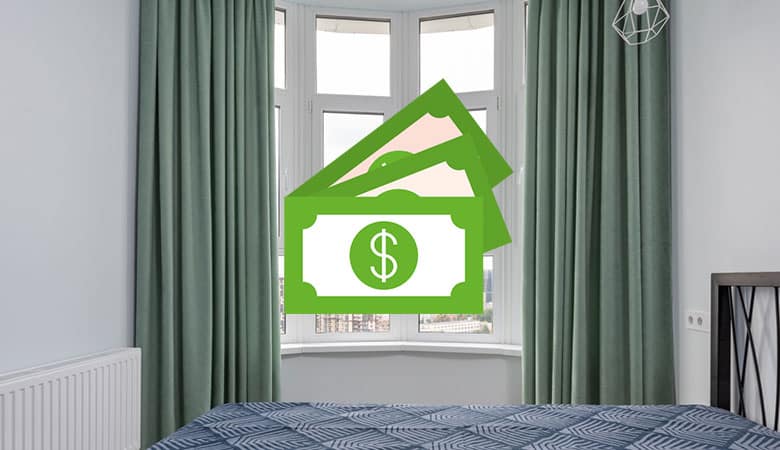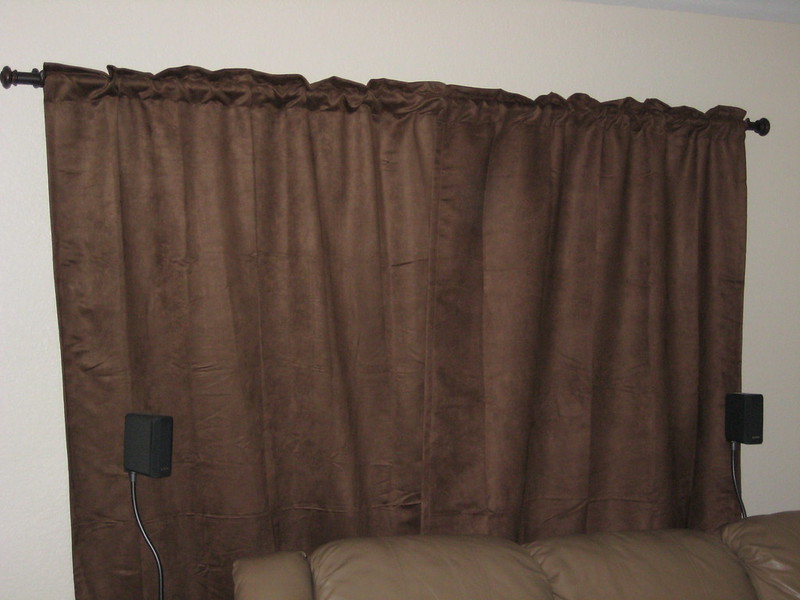This post is part of the blackout curtain buyers guide.
Blackout curtains are a popular choice for those of us who need complete darkness to sleep or enjoy sleeping in after the sun has come up. What if there are more benefits to fitting blackout curtains to your house windows? Let’s have a look at how blackout curtains could have an effect on your energy bill.
Blackout curtains can help to lower your energy bill. They can reduce your heating costs by up to 24%. This happens because of the thermal insulation that blackout curtains can provide. Your windows are definite weak points in the thermal envelope of your home. Adding a layer of insulation can have a big impact on your energy bill.
While this information might have you running off to the curtain store to upgrade the thermal efficiency of your home, it’s important to look a little bit deeper to make sure you make the right choice. This post will contain everything you need to know about how blackout curtains can save you money on your electricity bill.
The Unexpected Origin of The Blackout Curtain
So to get this ball rolling, let’s first look at the unexpected origins of the humble blackout curtain. As with a lot of things that are now commonplace in our day to day lives, blackout curtains have a somewhat dark start in World War II in Britain.
A popular method of attack in World War II was the air raid. And a lot of air raids happened in the dead of night. In an attempt to confuse the enemy planes, Britain started dimming all the lights that were blazing in the streets during the night.
This started with street lights and car headlights. There was even a ‘knitting for Britain’ campaign where children were knitting simple coverings for lights in order to confuse the enemy.
Eventually, this extended to blocking the light from residences as well. As it would be impractical to force everyone to keep all their house lights off at night, somebody came up with the idea of putting up light blocking covers over the windows.

This even became law in 1939 with blackout regulations in Britain. During this time, people began to notice the hidden benefits of blackout curtains; the complete darkness, the muffled outside noises, and the reduced need for climate control inside their homes.
They enjoyed these benefits so much that, when the war ended, many people carried on using their blackout curtains. As we live in a capitalist society, manufacturers saw this as an opportunity and rushed to improve the look, ease of use, and effectiveness of blackout curtains.
What Does This Story Have to do With my Energy Bill?
As we’ve discussed above, the first blackout curtains had one job: block light from leaving the windows so that the bomber jets can’t see where we are. In 2021, blackout curtains have a lot more work to do than simply blocking light.
They’ve been upgraded and improved to be sleek and aesthetically pleasing. They’ve been streamlined to improve ease of use. And they’ve been modified to be more effective at all the things that they do.
One of the areas of improvement has been thermal efficiency. Blackout curtains are an important part of plugging up any leaks in your home’s thermal envelope.
When you go to sleep at night, you most likely cover yourself with a blanket. That blanket traps your body heat and keeps you warm all night in a cosy little cocoon of the heat that your body produces naturally. You can think of blackout curtains as covering your windows with a nice heavy blanket.
What’s The Difference Between Blackout and Normal Curtains?
The main difference between blackout curtains and normal curtains is, as you may have guessed, the fabric. Normal curtains are typically one layer of fabric. Blackout curtains are a few layers of fabric, at least one of which has been specifically designed to block light.
These extra layers of fabric also add to the thermal efficiency of the curtains. If we use the blanket analogy again, it’s like adding an extra blanket or two to your windows.
A thin layer of air gets trapped in between the layers of the curtain. And it’s this thin layer of air that acts as a buffer between two different temperatures, namely, the indoor temperature and the outdoor temperature.
It can be helpful to look at double or triple paned glass to understand this concept better. These types of windows simply use a layer of air to drastically decrease the temperature exchange between the inside and the outside. Increasing the layers of air increases the thermal efficiency of your windows.
Can I Make my Blackout Curtains More Thermally Efficient?

Following on from the paragraph above, a simple way to work with the natural way these curtains work is to not disturb or ruffle the curtains once you’ve closed them. You want to keep that layer of air undisturbed. Ruffling your curtains could be seen as ‘resetting’ them.
Another way to maximise the thermal efficiency of your blackout curtains comes in the way that they are installed. If your curtains are not yet installed then these are some things you need to keep in mind.
- Make sure that, when closed, the curtains are actually touching the walls surrounding the windows on all sides. You might be able to hang the curtains inside the bay of the window which would be the most effective.
- Make sure they are long enough so that they just rest on the sill of the window. Make sure they are wide enough so that they touch the walls on the outside of the windows.
If your curtains don’t touch the walls above the window, this is not much of a problem. If you think back to science class in high school, you will remember that hot air rises. Which means that cold air sinks. So if there is a gap between the top of the curtains and the wall, all the cold air will be trapped between the curtain and the window in a pocket of cold air. This is known as stratifying.
Keep that in mind when you walk past those curtains. If you happen to brush the bottom of the curtain and it billows away from the wall, all that cold air that’s trapped behind the curtain will tumble down into your living space and make it a touch colder.
Thankfully, blackout curtains are often heavier than normal curtains. So ruffling them with a light breeze is not as easy.
You can even go as far as modifying your blackout curtains so that they create an air seal surrounding the window. This will make sure that trapped air will never be able to escape when you least need it to.
How to Fasten Your Blackout Curtains For Optimal Energy Efficiency

You can choose from a variety of methods of fastening the blackout curtains around the window. Obviously, aesthetic considerations will be a big factor here if you care what the inside of your house looks like. A velcro strip around the outline of your windows probably will not do much for any interior decor themes.
Going this far is not necessary though. Just making sure that the curtains touch the walls on the sides and the sill on the bottom when it hangs naturally should be enough to keep that cold air where it belongs: outside your living space.
Additional Blackout Curtain Energy Efficiency Tip
Another thing that can add to the energy efficiency of your blackout curtains is the way that you use them. If you live in a cold climate, you want to keep your curtains open when the sun is out. That way you allow the natural heat from the sun into your space. When the sun goes down, it’s time to close those curtains and keep all that warm air trapped inside your house.
If you live in a warm climate, you might have to keep your curtains closed during the day. This keeps the hot air outside of your home and keeps your interior cool and in the shade. Once the sun goes down, you can open those curtains and windows and take advantage of the cool night air. Just remember to close the curtains in your bedroom before you go to sleep if you want to keep your room dark in the morning.
Wrapping it up
The bottom line is that any curtains can make your house more energy efficient. Blackout curtains are more effective because of the extra layers involved. If you use them correctly, they could help to lower your heating and cooling bill by up to 24%.
If you are looking for blackout curtains for your own bedrooms/rooms then I recommend you read our blackout curtain buyers guide. In the guide we show our top three recommendations, what to look for in blackout curtains, their pros and cons and why we would consider using these ourselves.
Blackout Curtain Buyers Guide Parts:
1. What Are Blackout Curtains And What Are They Used For?
2. Are Blackout Curtains Worth Getting? The Pros & Cons of Having a Dark Bedroom
3. What Are Blackout Curtains Made of? The Best Fabrics to go For!
4. Are Blackout Curtains Expensive? The 7 Best Priced Curtains of 2021
5. Are Blackout Curtains Energy Efficient? Can They Lower My Energy Bill?
6. What Color Should Blackout Curtains be in?
7. Blackout Curtains vs. Blackout Blinds: Which are better?
8. How To Measure for Blackout Curtains: A step by step guide
9. How To Clean Blackout Curtains: A step by step guide
10. Best Blackout Curtains For The Bedroom: A Buyers Guide (2021)
